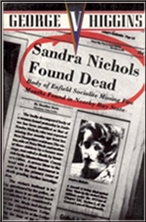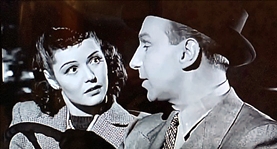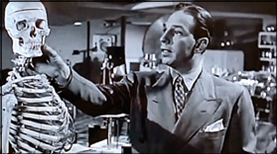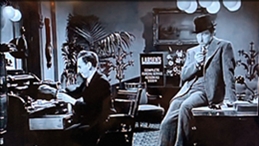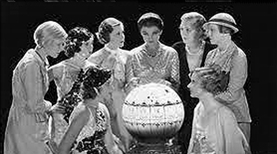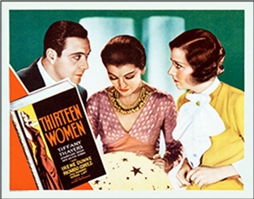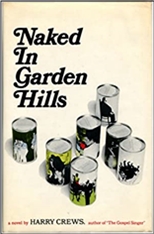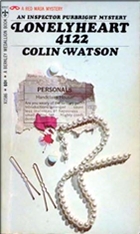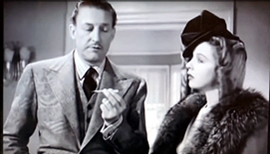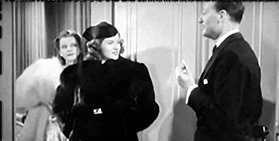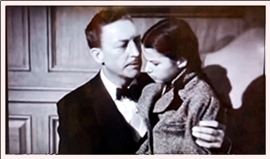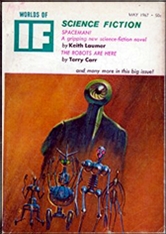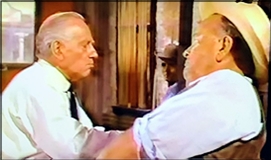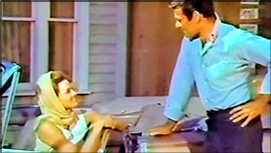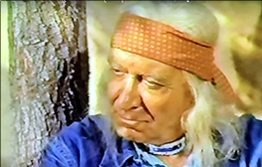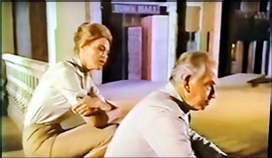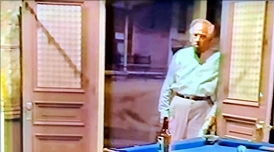Sun 4 Jun 2023
Nero Wolfe on Page and (Small U.S.) Screen: “Disguise for Murder†by Matthew R. Bradley
Posted by Steve under Reviews , TV mysteries[4] Comments
“Disguise for Murderâ€
by Matthew R. Bradley
Rex Stout’s Nero Wolfe collection Curtains for Three (1951) contains the now-standard three novellas published in The American Magazine: “The Gun with Wings†(December 1949), “Bullet for One†(July 1948), and “Disguise for Murder†(as “The Twisted Scarf,†September 1950).
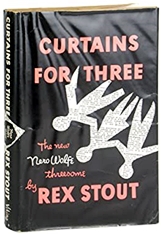
“The Gun with Wings†was not near the body of opera singer Alberto Mion — or so say his wife, Peggy, and would-be successor, Fred Weppler, who didn’t tell the police it only appeared later beside the supposed suicide. They want Wolfe to dispel the shadow of murder over their intended union; Archie has “occasionally let Lily Rowan share her pair of opera seats with me†so he recognizes a suspect, baritone Gifford James.
Continuing the ballistics theme, the “Bullet for One†knocks industrial designer Sigmund Keyes out of his saddle in Central Park; five of the suspects collectively hire Wolfe, some of them hoping he’ll nail the sixth, yet before long, all but one of the sextet is arrested for one reason or another.
In “Disguise for Murder,†the brownstone hosts “no such throng as that within [Archie’s] memoryâ€: at the suggestion of Bill McNab, garden editor of the Gazette, Wolfe has invited the Manhattan Flower Club to see his orchids. Fritz and Saul are manning the door while Archie — who regrets having agreed to help mingle — is taking a breather in the office, where he is joined by a panicked young woman, Cynthia Brown.
Con artists Cynthia and her “brother,†Col. Percy Brown, were brought by Mimi Orwin, their prospective mark, a wealthy widow hooked in Florida and accompanied by her son, Eugene. Cynthia was terrified when upstairs she recognized, and was recognized by, the unidentified man she’d seen entering Doris Hatten’s apartment, whom she believed was “keeping†her friend there — and strangled her with her own scarf immediately afterward, a crime that has baffled Cramer for five months.
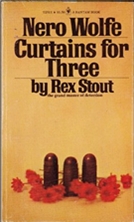
Promising to bring Wolfe down to hear her out, Archie returns to the plant rooms to keep a special eye on the men, including one who grabs a flower pot in an oddly menacing way, revealed as an actor, Malcolm Vedder.
The crowd has thinned to a trickle when the wife of Homer N. Carlisle, executive VP of the North American Foods Co., peeks into the office for a look at Wolfe’s famous three-foot-wide globe and finds Cynthia, strangled with, per Doc Vollmer, something like…a scarf.
Cramer grills the remaining visitors, held there by Fritz and Saul, but both he and Wolfe decline psychiatrist Nicholson Morley’s offer to question all men among the 219 guests, dutifully recorded by Saul, and try to identify the killer. In a spiteful, ill-advised move, Cramer insists on sealing the office as a crime scene; otherwise “Wolfe might have called his attention to a certain fact as soon as [he] saw it himself,†saving a lot of trouble.
Gleaned from Archie’s report but overlooked by him and Cramer, that fact leads Wolfe to a dangerous test of his theory: he sends a blackmail note to one suspect, who calls with an unfamiliar voice to make an appointment with Archie via an elaborate runaround and two cut-outs. Tied to a chair by those he dubs W-J (wrestler-jockey, for his mismatched torso and legs) and Skinny, he is at the mercy of the killer, at first unrecognizable.
But bribery turns the flunkies, and “he†is revealed as the cross-dressing wife of Doris’s sugar daddy, Carlisle; in the plant rooms, the men had all doffed their hats, yet Cynthia recognized the killer specifically because of the hat, assuming it to be a man, as she had at the apartment.
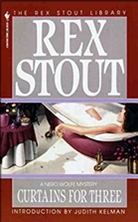
A first-season episode of A Nero Wolfe Mystery, “Disguise for Murder†(6/17/01) was one of four collaborations between director John L’Ecuyer and writer Sharon Elizabeth Doyle. As with the following consecutive pair, “Door to Death†(6/4/01) and “Christmas Party†(7/1/01), this and “Eeny, Meeny, Murder, Moe†(6/3/01), while based on widely spaced novellas, were linked by Doyle with original material for international broadcast and DVD as the respective faux telefilms Wolfe Goes Out and Wolfe Stays In. Here, her connective tissue is the often-invoked Thursday-night poker game played by Lon (Saul Rubinek), Orrie (Trent McMullen), Saul (Conrad Dunn), and Archie (Timothy Hutton).
When Archie relates a postscript to “Eeny, Meeny, Murder, Moe,†Fritz (Colin Fox) asks them to quit early to prepare for the onslaught, during which Wolfe (Maury Chaykin) and Archie struggle to keep smiling. The body of Doris (Tramara Burford) is seen briefly in flashback, and after Archie encounters Percy (Nicholas Campbell), Mimi (Nancy Beatty), Eugene (Phillip [sic] Craig), and Vedder (Beau Starr), that of Cynthia (Kathryn Zenna) is found by Mrs. Carlisle (Debra Monk). Repertory player Ken Kramer makes a second and final appearance as Vollmer — later played by Joe Flaherty in “The Silent Speaker†(7/14 & 21/02) — summoned as Homer (Aron Tager) blusters at the indignity of being detained.
As usual, the regulars are superb, e.g, Fritz bringing down Percy as he attempts to leave; Wolfe bellowing, “The police shall receive no sandwiches!â€; Saul coolly standing by his legendary memory; Cramer’s (Bill Smitrovich) glee as he has Lt. Rowcliff (an uncredited Bill MacDonald) seal Wolfe’s office.
The interrogations are intercut into a montage à la “Over My Dead Body†(7/8 & 15/01). A burgundy jacket and long hair visualize the odd persona of Morley (Richard Waugh), while the need for viewers to see and hear what had been simply described on the page causes the phone call to telegraph the killer’s gender a little more clearly before Skinny (Boyd Banks) and W.J. (James Tolkan) confront Archie.
— Copyright © 2023 by Matthew R. Bradley.
Up next: Murder by the Book
Edition cited —
Curtains for Three: Bantam (1970)
Online source —
